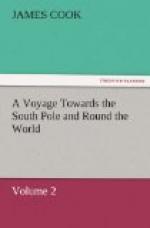On the 1st of February, at four o’clock in the morning, we got sight of a new coast, which at six o’clock bore N. 60 deg. east. It proved a high promontory, which I named Cape Montagu, situated in latitude 58 deg. 27’ S., longitude 26 deg. 44’ west, and seven or eight leagues to the north of Cape Bristol. We saw land from space to space between them, which made me conclude that the whole was connected. I was sorry I could not determine this with greater certainty; but prudence would not permit me to venture near a coast, subject to thick fogs, on which there was no anchorage; where every port was blocked or filled up with ice; and the whole country, from the summits of the mountains, down to the very brink of the cliffs which terminate the coast, covered, many fathoms thick, with everlasting snow. The cliffs alone was all which was to be seen like land.
Several large ice-islands lay upon the coast; one of which attracted my notice. It had a flat surface, was of considerable extent both in height and circuit, and had perpendicular sides, on which the waves of the sea had made no impression; by which I judged that it had not been long from land, and that it might lately have come out of some bay on the coast, where it had been formed.
At noon we were east and west of the northern part of Cape Montagu, distant about five leagues, and Freezeland Peak bore S. 16 deg. east, distant twelve leagues; latitude observed 58 deg. 25’ S. In the morning the variation was 10 deg. 11’ east. At two in the afternoon, as we were standing to the north, with a light breeze at S.W., we saw land bearing N. 25’ east, distant fourteen leagues. Cape Montagu bore at this time, S. 66 deg. east; at eight it bore S. 40 deg. east; Cape Bristol, S. by E.; the new land extending from N. 40 deg. to 52 deg. east; and we thought we saw land still more to the east, and beyond it.
Continuing to steer to the north all night, at six o’clock the next morning a new land was seen bearing N. 12 deg. east, about ten leagues distant. It appeared in two hummocks just peeping above the horizon; but we soon after lost sight of them; and having got the wind at N.N.E. a fresh breeze, we stood for the northernmost land we had seen the day before, which at this time bore E.S.E. We fetched in with it by ten o’clock, but could not weather it, and were obliged to tack three miles from the coast, which extended from E. by S. to S.E., and had much the appearance of being an island of about eight or ten leagues circuit. It shews a surface of considerable height, whose summit was lost in the clouds, and, like all the neighbouring lands, covered with a sheet of snow and ice, except in a projecting point on the north side, and two hills seen over this point, which probably might be two islands. These only were clear of snow, and seemed covered with a green turf. Some large ice islands lay to the N.E., and some others to the south.




